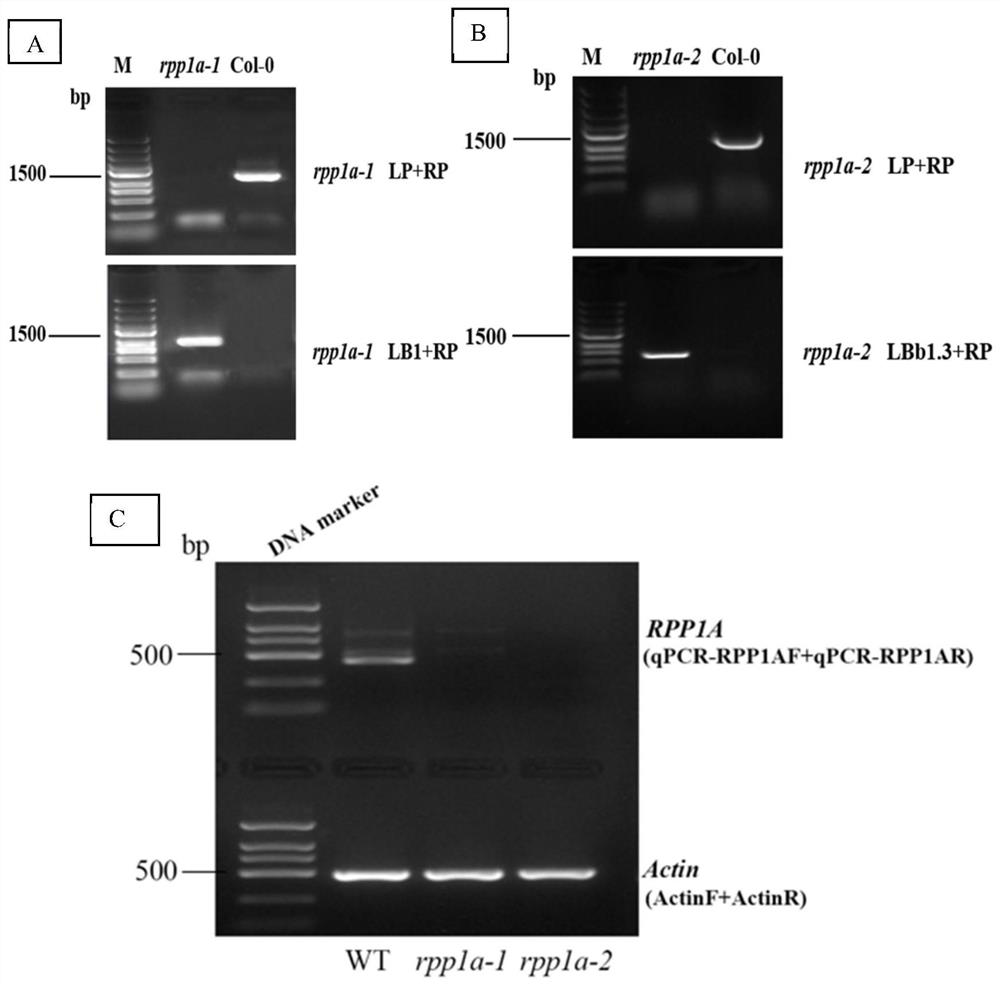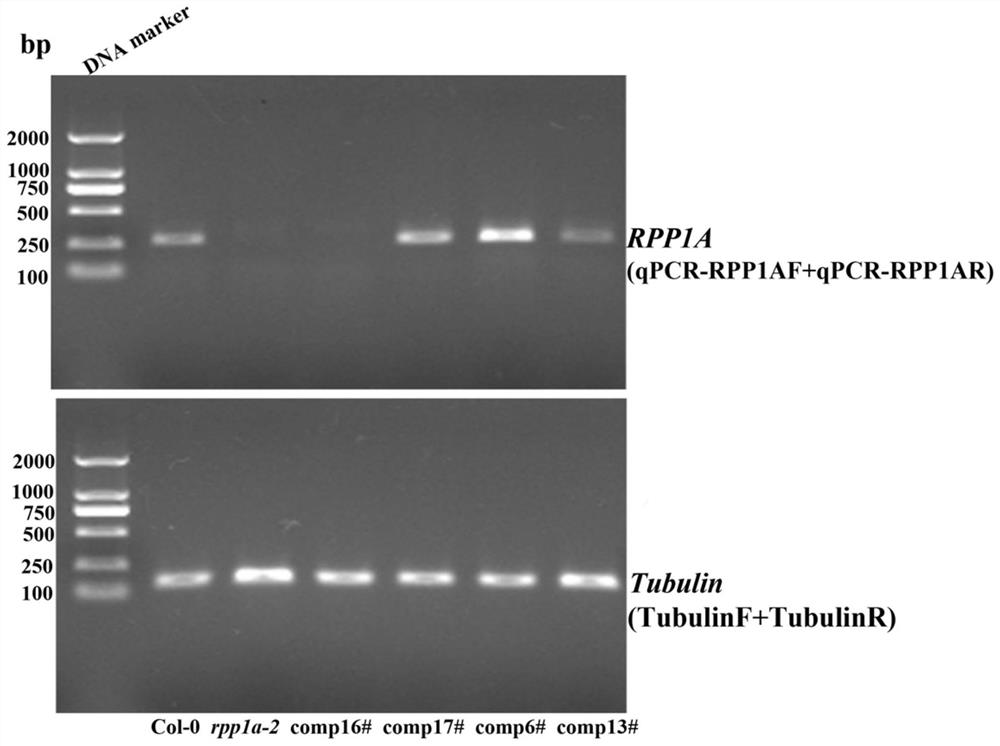Application of arabidopsis seed regulatory gene RPP1A
A gene and seed technology, applied in the field of Arabidopsis thaliana seed regulation gene RPP1A in controlling seed size and 100-seed weight, can solve the problem that there is no report on RPP1A protein
- Summary
- Abstract
- Description
- Claims
- Application Information
AI Technical Summary
Problems solved by technology
Method used
Image
Examples
Embodiment 1
[0016] Embodiment 1: T-DNA insertion homozygous mutant identification of Arabidopsis RPP1A gene
[0017] 1. Plant material
[0018] The seeds of the two T-DNA insertion mutants rpp1a-1 and rpp1a-2 of Arabidopsis RPP1A were purchased from the Arabidopsis Biological Resource Center (ABRC), and the storage numbers were SAIL_210_H01 and SALK_206736C, respectively. Such as figure 1 As shown, the T-DNA insertion site of the rpp1a-1 mutant is located in the promoter region, while the T-DNA insertion site of the rpp1a-2 mutant is located in the protein coding region, in the second exon region of the gene, and the wild-type Arabidopsis Col-0 was from our laboratory.
[0019] 2. Cultivation of Plant Material
[0020] Col-0, rpp1a-1, and rpp1a-2 were sterilized with 75% alcohol for 3 minutes, 0.5% sodium hypochlorite for 10 minutes, rinsed with sterile water for 5 times, vernalized at 4°C for 2 days, sowed on 1 / 2 MS medium, and exposed to light Box culture (16h light / 8h dark, 22°C) f...
Embodiment 2
[0035] Example 2: Semi-quantitative RT-PCR analysis of RPP1A gene T-DNA insertion mutants
[0036] In order to analyze whether the RPP1A gene is silenced in T-DNA insertion mutants, we performed semi-quantitative RT-PCR analysis, the specific method is as follows:
[0037] The total RNA of leaves of wild-type Arabidopsis Col-0, rpp1a-1, and rpp1a-2 plants was extracted by Trizol method, reverse-transcribed into cDNA, and the diluted cDNA was used as a template to perform PCR amplification with specific primers, respectively. The primer for Arabidopsis Actin.
[0038] The amplification primers are:
[0039] qPCR-RPP1AF:GGGGTACCATTTGATCCGTTTATACTTGTTATTG;
[0040] qPCR-RPP1AR:CAAAGAAGAAAGACAAGTGACTGCGT;
[0041] ActinF:GTTGGGATGAACCAGAAGGA;
[0042] ActinR: CTTACAATTTCCCGCTCTGC;
[0043] PCR reaction system
[0044]
[0045] PCR amplification conditions: pre-denaturation at 94°C for 3min; denaturation at 94°C for 30s, annealing at 55°C for 30s, extension at 72°C for 30s...
Embodiment 3
[0047] Example 3: Obtaining of transgenic plants complemented by RPP1A
[0048] 1. Cloning of the RPP1A gene
[0049] Using the CTAB method to extract the Col-0 genomic DNA, use the above DNA as a template, and use primers RPP1AF and RPP1AR containing restriction sites for PCR amplification. The amplification primers are:
[0050] RPP1AF:CCGGAATTCGTGTAATGTGTTTAATTACTTTTTGGT;
[0051] RPP1AR:CGCGGATCCTGGTAGAAAATAAACAAAATCAATTC;
[0052] PCR reaction system
[0053]
[0054] The PCR reaction program was: pre-denaturation at 94°C for 3 min; denaturation at 98°C for 10 s, annealing at 56°C for 15 s, extension at 72°C for 20 s, 35 cycles; extension at 72°C for 5 min.
[0055] The above-mentioned PCR amplification products were detected by 1% agarose gel electrophoresis, and a target fragment was recovered, connected to a carrier, transformed into E. coli competent cells, and a single clone was picked and sent for sequencing.
[0056] 2. Construction of recombinant plasmids ...
PUM
 Login to View More
Login to View More Abstract
Description
Claims
Application Information
 Login to View More
Login to View More - R&D
- Intellectual Property
- Life Sciences
- Materials
- Tech Scout
- Unparalleled Data Quality
- Higher Quality Content
- 60% Fewer Hallucinations
Browse by: Latest US Patents, China's latest patents, Technical Efficacy Thesaurus, Application Domain, Technology Topic, Popular Technical Reports.
© 2025 PatSnap. All rights reserved.Legal|Privacy policy|Modern Slavery Act Transparency Statement|Sitemap|About US| Contact US: help@patsnap.com



